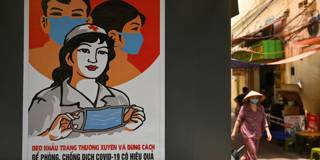A deep determination to battle against great odds may explain why East Asia has so far responded much better to the COVID-19 pandemic than most Western countries. And if the region’s economies also recover faster, they may well offer a glimmer of hope to a world currently drowning in pessimism.
SINGAPORE – Death tolls don’t lie. The most striking disparity in COVID-19 fatalities to date is between East Asian countries, where the total number of deaths per million inhabitants is consistently below ten, and much of the West, where the numbers are in the hundreds. For example, Japan has so far reported 7.8 deaths per million, followed by South Korea (5.8), Singapore (4.6), China (3.2), and, most remarkably of all, Vietnam, with zero deaths. By contrast, Belgium now has 846 confirmed deaths per million, and the United Kingdom has 669, followed by Spain (608), Italy (580), and the United States (429).
What accounts for this extraordinary difference? The answers are complicated, but three possible explanations stand out. First, none of the East Asian states believe that they have “arrived,” much less achieved the “end of history” at which they regard their societies as being the apotheosis of human possibility. Second, East Asian countries have long invested in strengthening government institutions instead of trying to weaken them, and this is now paying off. And, third, China’s spectacular rise is presenting its regional neighbors with opportunities as well as challenges.
It’s always dangerous to oversimplify. Yet, the evidence shows that whereas Europeans tend to believe in state-sponsored social security, East Asians still believe that life is composed of struggle and sacrifice. French President Emmanuel Macron is battling to overhaul his country’s pension system and decrease retirement benefits in order to achieve much-needed reductions in budget deficits. As a result, France was convulsed for months by “Yellow Vest” protests. But when South Korea faced a far more serious financial crisis in 1997-98, old ladies donated jewelry to the central bank in an effort to help.

SINGAPORE – Death tolls don’t lie. The most striking disparity in COVID-19 fatalities to date is between East Asian countries, where the total number of deaths per million inhabitants is consistently below ten, and much of the West, where the numbers are in the hundreds. For example, Japan has so far reported 7.8 deaths per million, followed by South Korea (5.8), Singapore (4.6), China (3.2), and, most remarkably of all, Vietnam, with zero deaths. By contrast, Belgium now has 846 confirmed deaths per million, and the United Kingdom has 669, followed by Spain (608), Italy (580), and the United States (429).
What accounts for this extraordinary difference? The answers are complicated, but three possible explanations stand out. First, none of the East Asian states believe that they have “arrived,” much less achieved the “end of history” at which they regard their societies as being the apotheosis of human possibility. Second, East Asian countries have long invested in strengthening government institutions instead of trying to weaken them, and this is now paying off. And, third, China’s spectacular rise is presenting its regional neighbors with opportunities as well as challenges.
It’s always dangerous to oversimplify. Yet, the evidence shows that whereas Europeans tend to believe in state-sponsored social security, East Asians still believe that life is composed of struggle and sacrifice. French President Emmanuel Macron is battling to overhaul his country’s pension system and decrease retirement benefits in order to achieve much-needed reductions in budget deficits. As a result, France was convulsed for months by “Yellow Vest” protests. But when South Korea faced a far more serious financial crisis in 1997-98, old ladies donated jewelry to the central bank in an effort to help.